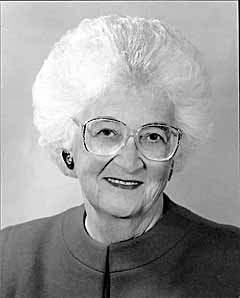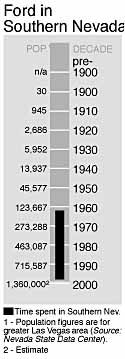Jean Ford



When Jean Ford learned she had terminal cancer, she faced her own death with the same weapons she used to change Nevada.
“She organized it,” said her daughter, Janet Spelman. Her voice dropping to a whisper, Spelman repeated, “She organized it.
“Of course, she was shocked and angry at first, as anybody would be,” Spelman continued. “But then she sat down with my sister and me, took out her calendar, and started crossing off things that weren’t important any more. She showed us what was left, and said, `This is what I want to do. What do you guys want to do?’ ”
With an estimated year to live, they started scheduling. There were holidays with daughters and grandchildren. There was a tour of Northern Nevada with a play Ford had written and intended to narrate. There was a visit to the Cowboy Poetry Gathering at Elko, with women who had become her allies and friends over some 30 active years in Nevada. She kept her commitments.
Ford wrought many changes. The Clark County Library started as a joint project between herself and her then-husband, Dr. Samuel Ford. She was president of the Clark County League of Women Voters during some of its most effective years, when it helped bring about integration of Clark County schools. She wasn’t the sole founder of either, but the local chapter of Sierra Club and Archeo Nevada, dedicated to preserving Nevada’s natural resources and prehistory respectively, were born in her living room.
Former Lt. Gov. Sue Wagner, who served with Ford in the Nevada Senate, said, “In terms of changing the legislative process, making it more accountable, Jean Ford was more important than anybody else.” Familiar with every small town and crossroad in Nevada, Ford helped create the Nevada Department of Tourism, which spread the bonanza of visitors to smaller cities.
Historian James Hulse of UNR added, “She discovered something about the empowerment of women. … She discovered that if you organize and plan your strategy, you can get a lot done. She taught others how to do it. She saw it as her mission to empower others, and particularly women.”
Ford established the Nevada Women’s Archives at UNR and UNLV, and the Nevada Women’s History Project. Days after word of her terminal diagnosis spread through the academic community, NWHP dispatched an oral historian to record her story, published in a limited edition in 1998 under the title, “Jean Ford: A Nevada Woman Leads The Way.”
Ford was born in 1929 in Miami, Okla., as Imogene Evelyn Young, daughter of an insurance salesman. In her oral history, Ford described her mother as romantic and fun-loving, but mentally unstable. “One day she ran away and went back to the hospital on her own accord … and then she never left there for the rest of her life,” said Ford.
Ford was 9. Until her father’s divorce and remarriage, she helped look after her brother, Byron.
In Joplin, Mo., Ford became a superior student but developed a stutter, which she never completely overcame. “I don’t remember in just one-on-one conversation ever having much of a problem. Reciting in class, reading out loud from fixed words, any of that, I got to where I could not do it.” It didn’t keep her from becoming valedictorian of her high school class or making the required speech. She suggested that her inability to speak eloquently made her strive to excel at all else. Ballet. Tap. Folk dance. Violin in the student orchestra. Even singing with a madrigal group.
She also became active in Girl Scouts. “She earned 55 merit badges, which I believe was all there were to earn at the time,” said her daughter, Carla Oberst. She majored in sociology at Southern Methodist University, and joined the Red Cross as a recreational worker.
Assigned to a military hospital in Hawaii, she taught ukulele to a young intern. They were married in 1955. Samuel Ford eventually specialized in dermatology. The Fords moved to Las Vegas in 1962. By then they were four, including Janet, born in 1956, and Carla, born in 1958.
The family built a house on the golf course now called National, in Paradise Palms. Accustomed to lusher climes, the Fords began exploring their exotic desert surroundings.
“She would sit down at the typewriter and type an outline of a camping trip,” remembered Janet. “From a packing list to what our first, second, and third stop would be, and on a map she would have a red line drawn.
“In her mind, she did it so we would have more fun and nothing would go wrong,” but the meticulous organization “used to drive us nuts,” said Spelman. “I’m a more spontaneous person, I like to grab stuff and get in the car, and that drove her nuts …
“We had a big yellow International Travelall, and went all over the state in it. We would be driving along, and she would say ‘Pull over, Sam!’ Very excited about seeing some wildflower, and she would bring one back to the car, and flip through her wildflower books until she found it. I have some of her old wildflower books, and there are dried flowers between the pages. She has one of nearly every flower in the book.”
The Fords’ delight in their natural surroundings was not matched by their reaction to local conveniences. They lived in unincorporated Clark County, which had no library. The Fords suggested their local Unitarian fellowship take on organizing a library.
At the time, forming a library district required getting signatures of property owners representing 51 percent of total value in the proposed district. There were many absentee owners, hard to contact and generally uninterested once found.
John Porter, civil deputy in the Clark County District Attorney’s Office, suggested looking for a more workable law in some other state. California law required signatures representing only 10 percent of the property, but also required voter approval. Ford journeyed to Carson City and asked that Nevada adopt the same rule, and it did, ultimately resulting in today’s Las Vegas-Clark County Library District.
In the early ’60s federal legislation mandated that the Bureau of Land Management inventory its lands and determine which should be sold for urban development. Some real estate developers cast avaricious eyes upon scenic Red Rock Canyon. Just the site for condos.
Others, such as the Fords and their buddies in the Sierra Club, thought it ought to be preserved for public use. Ford signed up with the Clark County League of Women Voters because it was planning to address the parks issue, and one of her first activities for the League was surveying Las Vegans about it. Setting up a booth at the Jaycee State Fair, the women gathered more than 750 responses in two days. Strong community support was used to justify the preserve that eventually became the Red Rock National Conservation Area. Gov. Paul Laxalt appointed Ford to the Nevada State Parks Commission, where she served from 1967 until 1972.
Ford shortly found herself president of the League. While she was leader the League tackled the toughest social issues Las Vegas ever faced, such as school integration.
Harriet Trudell, now a Washington lobbyist for a think tank called Feminist Majority, worked on that project.
“The point we made was that the schools attended by black children were separate, but not equal, and we proved it. We proved they bused white kids right by the black schools, so the neighborhood schools argument they used was a farce.”
With this ammunition in hand, said Trudell, “Jean was the one who had the courage to say `Let’s go.’ ” The League filed an amicus brief supporting an NAACP lawsuit against the Clark County School District and won the case in federal court.
Ford’s work with the League immersed her in the Nevada Legislature, where she became a fixture in the public balcony. One day Sen. Carl Dodge asked, “Have you thought about moving down a few rows?”
Instead, in 1972 she ran for the Assembly.
In her first term Ford served with Mary Gojack, D-Reno, on the government affairs committee. They were early advocates of reforms such as an ethics bill and registration of lobbyists, which didn’t pass at the time, but eventually did.
Ford returned to the Legislature in 1975 and pushed through a bill requiring employers to give equal pay, hours and working conditions regardless of gender.
“At that point Nevada had a law that said an employer could hire a woman at less than the minimum wage for 90 days, and it was called a probationary period,” she recalled. “That was only for women, not for men. … What was happening in reality is they would hire a woman for 90 days, then fire her and hire another woman for 90 days.” Nevada also forbade women to work more than eight hours a day or 40 a week. This was originally intended to protect women from the sweatshop system, said Ford, but by 1975 “it really limited the kinds of jobs women could get.”
Ford was for equal treatment, even for men. In the 1970s she was one of the first legislators to advocate giving men the same rights as women in custody disputes.
One thing people noticed about Ford was an egalitarian respect for whatever work people chose to do. Ford barely blinked when her daughter, Spelman, became a showgirl. “My sister Carla became a doctor, and of course my mother was very proud of her,” said Spelman. “But every time my mother mentioned that to anybody, she also mentioned that I was in ‘Hallelujah Hollywood.’ ”
In 1976 Ford ran for the Nevada Senate and lost, partly because the Republican Party leaders failed to support her. So she became a Democrat, and won a seat in 1978.
“She helped me increase marriage license fees to fund domestic violence shelters in the state,” remembered Wagner. “She helped me establish Displaced Homemaker Centers, and I think the first was at the community college in Southern Nevada. When women are thrust back into the workforce by death or divorce, after being homemakers for 20 years during which the technology of the workplace has completely changed, they can go there to learn computer skills, for instance.”
Ford was an untiring advocate of the Equal Rights Amendment, but the Nevada Legislature did not ratify it.
She did not run for re-election to the Senate largely because her marriage to Samuel broke up in 1977. Being divorced required her to work full time.
In 1980 Ford and a group of her friends formed Jean Ford Associates, a company capitalizing on skills they had developed in volunteer work. In her oral history Ford said, “What I found is … for the most part the public did not want to pay me to deliver those kinds of skills. They were too used to getting them for free.” Jean Ford Associates lasted only a year, but Ford did better as a sole proprietor of Jean Ford Co., offering much the same services. In 1983 she teamed up with Maxine Peterson in Nevada Discovery Tours, which arranged bus tours of Nevada’s scenic areas and historic mining towns, largely as daytime amusement for spouses while their mates attended Las Vegas conventions.
She served on the tourism commission in the late 1970s and as director of community services from 1985 to 1989, then went to work for a Reno casino.
Ford was hired in 1991 as acting director of UNR Women’s Studies, an interdisciplinary academic program revolving around women’s relationship to society. She began teaching courses with names like “Women in Politics” and “Women in Public Leadership.” They used standard leadership texts, but Ford augmented them with guest lectures by 20 prominent Nevada women.
In 1992 she offered a course on “Nevada Women on the Frontier,” and asked UNR’s special collections section to give her a list of Nevada women on whom enough information had been gathered for students to research term papers. “They came back to me with a list that was shorter than the number of students I had in the class,” said Ford.
It was her first realization that most of women’s contributions in Nevada had gone undocumented. She mounted a campaign to locate letters, diaries, and other documents. The Nevada Women’s Archive, as it was named, soon had a branch at UNLV as well. By 1998, Ford estimated the effort had gathered at least 500 collections of papers from women who had played some role in state history. When UNR finally found a permanent director for Women’s Studies, Ford was free to throw herself into founding the Nevada Women’s History Project, which supports such efforts as researching biographies of women, posting them on the internet, publishing a newsletter/history magazine and organizing historical tours.
In the fall of 1997 Ford learned she had pancreatic cancer, and that it probably would kill her within a year. She spent much of that winding up projects already started. She had written a play about a visit to Nevada by Sara Bard Field, the suffragette who crossed the United States in an Overland automobile in 1916. Ford narrated seven performances in five days.
Friends helped her organize 30 years worth of color slides and prints taken in Nevada’s back country, and she donated them to the Nevada State Museum. She organized her personal notes chronologically, making her oral history one of the most thorough — and frank — ever gathered in Nevada.
On the last day of her life, daughter Oberst related, “Her friend Kate Butler brought her guitar in, Maya Miller was there … and we sang old campaign songs. One of them goes, ‘You can ride on the Jean Machine./ Come take a ride, see what we mean./ It’s all hand-tooled and it’s people fueled,/ The Jean Machine Mobile.'” She rarely opened her eyes by then, but she was singing, and she was smiling.
Ford died Aug. 26, 1998, at her home in Carson City.
Part III: A City In Full











